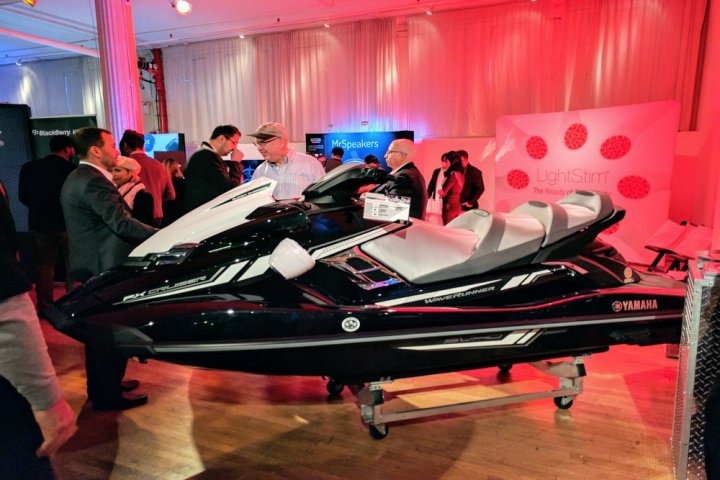
But not everything was priced sky high. Affordable instant cameras and headphones were alos on display, as were apps that cost no more than the price of a couple of Starbucks lattes.
Here’s some of the coolest tech we saw.
Lomo’Instant

There’s a burgeoning market for Polaroid-like instant cameras, and Lomography’s Lomo’Instant Automat Glass is one of the best yet. It’s the first full-frame model with a six-element, 38mm wide-angle glass lens and two apertures (f/4.5 and 4/22) — tech that in tandem delivers “unparalleled” low-light performance. An intuitive click-and-stop zoom system and 0.3m focusing distance helps with macro photography, and a built-in flash illuminates dimly lit subjects. Perhaps best of all is the Auto Mode that brings it all together: When enabled, the Automat Glass intelligently tailors the shutter speed, aperture, and flash output to current conditions.
The first available version of the Automat Glass, the Magellan Edition, features a faux-leather cover and geometric design inspired by “pioneering voyages and stargazing observatories that paved the way for new discoveries.” It starts at $189, and ships bundled with a 0.1m close-up lens attachment, a multi-exposure lens, a remote control lens cap, and a colored gel filter.
LightStim LED Bed

LightStim sells a whole range of pricey therapeutic products, but the company’s flagship is a bed outfitted with 18,240 LED lights — the first and only LED bed to gain over-the-counter clearance with the Food and Drug Administration. It packs individual temperature-controlled modules that “help encourage the release of nitric oxide and ATP,” which ostensibly “increase [overall] stamina and performance.” The company’s advertising paints it as the pain-reducing, wrinkle-removing holy grail of wellness.
So what’s it feel like, exactly? Basically a warm bed. It’s not as toasty as a tanning bed, but you’ll emerge from the LightStim’s glass surface flushed and thirsty. LightStim claims the discomfort is worth it, pointing to more than 200 medical and university studies showing that LED light therapy protects against UV damage, cardiovascular disease, heart attacks, and strokes. Testimonials from customers claim that it enhances post-exercise recovery and muscle regeneration. For the base price of $60,000 base price, that’s the least it could do.
Vinci Smart Hearable

Headphones generally aren’t the most interesting gizmos in the room, but Vinci Smart Hearable wants to change that. The Indiegogo-backed cans pack a touchscreen computer running a full-blown operating system, including apps like Spotify and SoundCloud. Amazon’s Alexa assistant is built in — you can ask the Vinci to play a song, answer an incoming call, or read a text message with a simple voice command. An integrated heart rate monitor, meanwhile, adjusts the tempo of your tunes on the fly.
There’s more to the Vinci than meets the eye. A proximity sensor automatically pauses the music when you take the headphones off, and a SIM card slot lets you stream music without Wi-Fi. There’s 16GB of storage for apps, music, and more. And a special mode taps the Vinci’s twin microphones to create binaural 3D audio recordings.
The $100 Vinci is nothing if not ambitious, but there’s work to be done — in our brief time with the headphones, we couldn’t get Alexa to work properly. Company reps assure us, though, that the software is a work in progress.
Ono 3D printer

3D printers are a category of products with boundless potential, but they’re not known for being the most portable gadgets around. Enter the Ono 3D, a 3D printer that aims to squeeze the guts of a 3D printer into a compact, lightweight accessory that’s compatible with any smartphone.
It’s impressively intuitive. Fire up the Ono app, pick a 3D model, and pour resin into the Ono’s reservoir, and you’re well on your way. Once you close the cover and affix your smartphone, the printing process begins, using the white light from the display of your phone to harden the photosensitive resin into a 3D model. The entire process takes about two hours.
The Ono 3D printer starts at $100, and began shipping to Kickstarter backers earlier this month after a lengthy delay.
DropCar

Trying to find parking in a city as congested as New York is an exercise in futility most days. That’s where DropCar comes in: For a monthly fee, you get an on-demand valet who can meet you at a specified address, take your car, and bring it back when you need it.
On-demand valet costs $15 an hour and up, and monthly parking services start at $350. For a little more, you get extras like a full tank of gas and a car wash.
If the idea of leaving your car with a relative stranger is off-putting, DropCar assures us that its drivers and valets are carefully screened and undergo “rigorous” training. They’re also monitored by Zendrive, a technology that uses sensors on a smartphone to measure and improve driving behavior.
DropCar is a New York-only affair for now, but the company is planning an expansion to other metro areas in the coming months.

